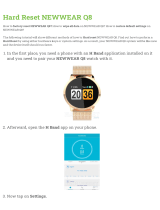
3
Taking a quick photo .............................57
Using Shot & Clear mode .......................57
Using Dual camera mode ....................... 58
Using Time catch shot mode ..................58
Once you've taken a photo.....................59
From your Gallery ..................................60
Video camera ..........................................61
Getting to know the viewfinder ..............61
Using the advanced settings ..................62
Recording a quick video ......................... 63
After recording a video...........................63
From your Gallery ..................................64
Adjusting the volume when viewing a
video .....................................................64
Using Audio Zoom .................................. 64
Using Dual recording mode .................... 65
Using Tracking zoom mode ....................65
Function ..................................................66
QuickMemo ...........................................66
Using the QuickMemo options ..............67
Viewing the saved QuickMemo ............67
QuickTranslator .....................................68
QSlide ....................................................69
QuickRemote .........................................70
Zoom to Track ........................................ 71
Live Zooming .........................................72
VuTalk ...................................................73
Register VuTalk Before Use ....................73
VuTalk Settings ......................................73
Communicate Visually with VuTalk ........74
Voice Mate.............................................74
Use Voice Mate ......................................75
Voice Mate Settings ...............................75
LG SmartWorld ......................................75
How to Get to LG SmartWorld from Your
Phone .................................................75
How to use LG SmartWorld ...................76
On-Screen Phone ..................................76
On-Screen Phone icons ........................76
On-Screen Phone features ...................77
How to install On-Screen Phone on your
PC ......................................................77
Multimedia ..............................................78
Gallery ................................................... 78
Viewing pictures ..................................78
Playing videos .....................................79
Editing photos......................................79
Deleting photos/videos .........................79
Setting as wallpaper ............................79
Videos ...................................................79
Playing a video ....................................80
Video Editor ...........................................81
Music ....................................................82
Add music files to your phone ............... 82
Transfer music using Media sync (MTP) 83
Playing a song .....................................83
Utilities ....................................................85
Slide Aside (Quick task-switching with
THREE fingers) ...................................... 85
Guest Mode .........................................85





















